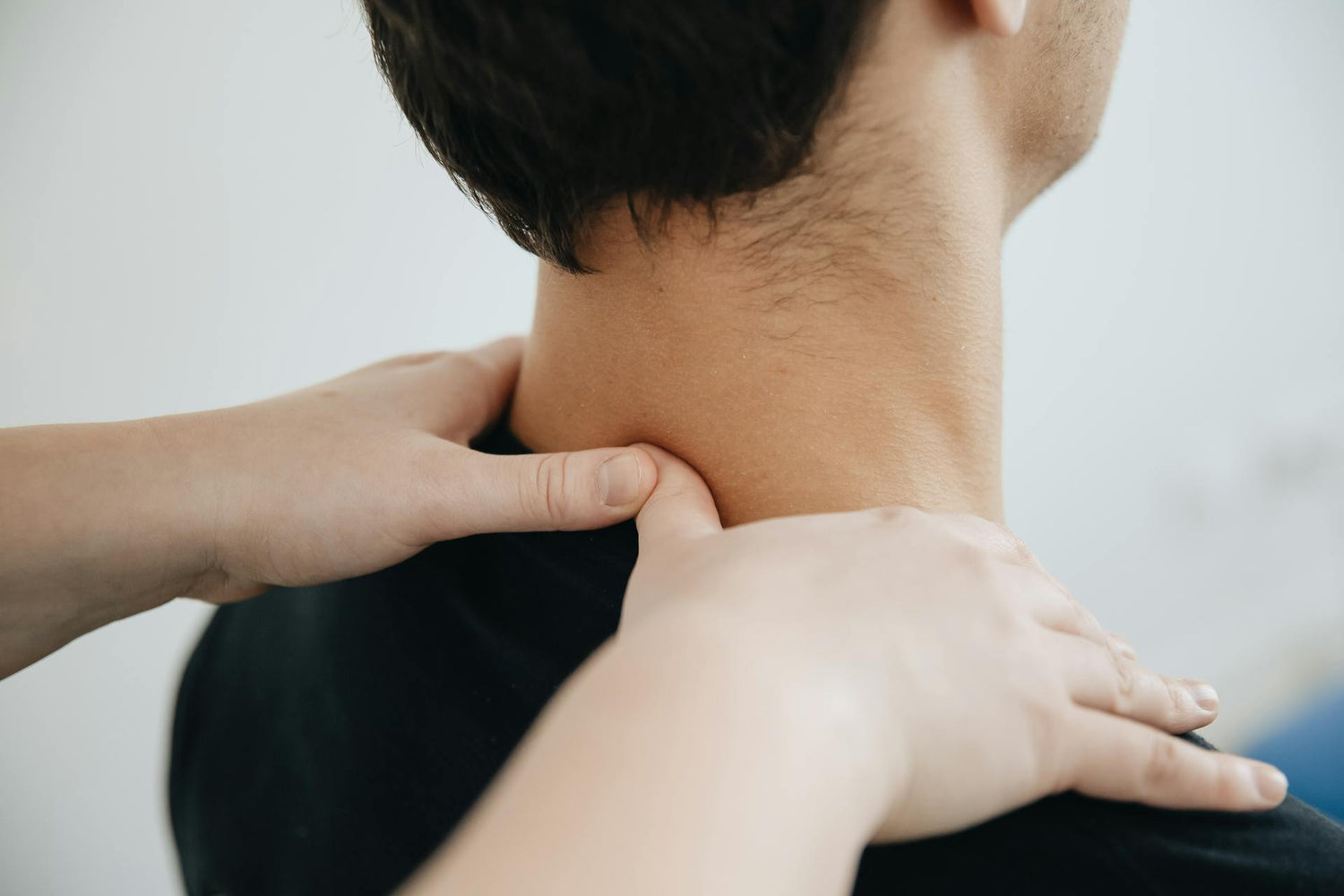Have you ever noticed just how much tension lives in your trapezius muscles? If so, you’re certainly not alone. These busy back muscles are some of the hardest working in the body, and they’re also some of the ones most prone to stress and anxiety.
Their tendency to tighten up is also why they’re a hotspot for trigger points (or muscle knots) — with one study finding that 93% of people with chronic neck pain also had trapezius trigger points.
So, if you’re dealing with painful knots in your traps, how can you get rid of them — and are there any ways to keep them away in the future? Read on to discover four remedies to try, plus a few prevention tips to add to your daily routine.
What Exactly Is a Trigger Point?
Simply put, trigger points (or knots) are tiny, irritable spots that can form within your muscles. They show up most often near the shoulder blades and neck, but they can appear in any muscly area. They’re usually sensitive to the touch and can cause pain that radiates to other places, sometimes far away from the knot itself.
At a closer level, the muscle fibers in trigger points are tense and contracted, which is what gives them their knot-like structure. The surrounding fascia (your body’s connective tissue) can also get tight or “sticky,” making knots feel stiffer and harder to release.
What Causes Trapezius Trigger Points?
Knots can form for all sorts of reasons, but it often comes down to a mix of overuse, stress, or your everyday habits. That being said, here are three causes worth looking into if your traps have been giving you trouble lately:
Poor Posture
Do you tend to lean forward while using your computer, or hunch over when looking at your phone? It might surprise you to learn that this type of posture — where you’re craning your head or rounding your shoulders forward — could be contributing to the formation of trapezius trigger points.
Experts generally agree that muscle knots form due to microtrauma, and poor posture is one thing that can predispose the trapezius to trauma from day-to-day activities. Plus, hunched forward posture can itself cause the trapezius muscles to lengthen and work harder as they hold up your body. And over time, this repetitive, chronic stress can play a major role in knots forming.
Emotional Stress
We often think about stress as only impacting mood, but the truth is it has a physical impact, too — influencing everything from your heart to sleep quality, and yes, even your muscles. And when it comes to the trapezius, both chronic and acute stress can increase your odds of trigger points for a few key reasons:
- Stress activates your body’s fight-or-flight response, and part of this response can involve heightened muscle tension in the neck and shoulders.
- Over time, stress-related tension can restrict blood flow and affect muscle healing.
- Studies show that during high levels of mental stress, the trapezius muscles have fewer “rest” periods than normal — or, in other words, they stay tense or partially contracted for longer.
Overload or Repetitive Movements
Whether it’s from lifting heavy objects at work, training at the gym, or playing a sport, overuse can put a lot of strain on your traps. And in the long term, if you don’t give your body enough recovery time between activities, painful knots may form.
Here’s why: Trigger points act as your body’s “guarding” mechanism for injuries, and overworking your trapezius muscles leads to tiny microtears and inflammation. While inflammation is a normal part of your body’s repair response, continuously straining the tissue again and again can disrupt the healing process — causing your body to perceive the area as constantly injured and form knots as a result.
Side Effects of Trapezius Trigger Points
While trapezius trigger points can be uncomfortable on their own, it turns out that localized pain isn’t the only symptom they bring. Side effects may include:
- Referred pain in the neck, shoulders, or temples
- Tinnitus (or ringing in the ears)
- Temporomandibular joint pain (TMD), which can occur due to changes in body mechanics and referred jaw tension
- Stiffness and reduced range of motion in the neck, shoulders, and upper back
How To Get Rid of Trapezius Trigger Points: 4 Remedies
Trapezius knots can be tricky, especially when they’ve built up slowly due to months of poor posture, stress, or overworking your back. Here are a few trusted techniques — both professional and home options — that may help them release:
1. Self-Massage
When you have a painful knot in your trapezius, self-massage can often bring some relief. Specifically, one of the go-to methods for breaking up trigger points is called myofascial release. This slow, targeted massage aims to ease tension in both the muscle tissue and fascia around it, and all it takes is a few minutes with a small massage ball. Here’s how to try it:
- Grab your ball of choice (a tennis ball or lacrosse ball both work well), and place it inside the end of a long sock.
- Stand with your back facing a wall, and sling the sock over your shoulder.
- Align it with the tender point or knot you want to focus on.
- Lean back with moderate pressure, and gently roll your body across the ball to break up the trigger point. (Optionally, you can pause and hold the pressure over the point for 20-40 seconds to encourage it to release.)
Tip: Pay attention to how the knot feels as you put pressure on it; it may feel uncomfortable at first, but after several seconds, you should feel some tension relief. If it starts feeling more irritated instead of getting better, it’s a sign to hold off on massage until your muscles have had more time to recover.
Try a Neck-Massager for Upper Trap Tension

If the knots in your traps are creeping up into your neck, a high-quality neck massager can be a great way to give your muscles some TLC. One trusted option is the MedMassager Neck Massager, a user-friendly tool that blends heat and kneading motions to soothe and release tense muscle tissue. It works like this:
- Place the massager around the back of your neck. Use the straps to keep it securely and comfortably in place.
- Switch the massager to its lightest pressure setting, allowing your muscles to warm up to the motions for one minute. (Optionally, you can turn on the heat setting to help relax the tissue further.)
- Relax and allow your trapezius and neck muscles to soak up the massage for 5-15 minutes.
2. Stretching and Strengthening Movements
When it comes to trap tension, the right stretching and strengthening routine can go a long way in bringing relief — and it’s why trigger point treatment often includes some form of physical therapy.
For example, building strength in the lower traps can help support healthier posture, reducing tension around the upper traps as a result. In addition, spending some time gently stretching the upper back and neck can boost blood flow and muscle elasticity. Some simple movements to add to your weekly routine could include:
Cat-Cow Yoga Stretch
The cat-cow pose is an easy yoga stretch that helps loosen the trapezius muscle tissue and surrounding fascia. To try it:
- Get into a tabletop (all fours) position on a comfortable surface.
- Inhale deeply, and curve your spine downward as you lift your head up.
- Next, exhale slowly and arch your back forward into a C-shape (think like a scared cat) as you lower your head toward the ground.
- Repeat for 60 seconds.
Scapular Squeezes
If you suspect that poor posture has been feeding into your trigger points, scapular squeezes can help. This simple movement helps to “pull in” the lower and middle traps, which tend to weaken and stretch as a result of forward posture. In turn? It can help take strain off the upper traps while reminding your body to keep your shoulders down and back.
Simply:
- Stand tall with relaxed posture.
- With your arms to your sides, bend your elbows at 90 degrees so that your hands point forward.
- Use your back muscles to squeeze the shoulder blades together. As you do so, your arms should rotate outward. (Tip: Really think about activating the lower traps here!)
- Repeat 8-10 times, up to a few times per day as needed.
3. Try Heat Therapy for Built-Up Tightness
When you put heat on your muscles, a few key things happen: blood flow increases, tension decreases, and research shows that pain levels can go down, too. It’s important to note that heat shouldn’t be used on any recent, inflamed injuries — but if you’re dealing with a chronic trigger point or tension in the traps, it could bring some welcome relief.
You can try using moist heat on your trigger point(s) with the help of a steamed towel or hot shower, which can penetrate the tissue more quickly than dry heat. But if you want to keep things simple, you can opt for a warm compress or heating pad instead.
4. Explore Professional Treatments
Finally, check in with your healthcare provider if your trigger points don’t seem to be getting better over a week or so of rest, massage, and self-care measures. A physician can help you identify any underlying factors that could be causing trapezius tension, as well as help you explore treatments like:
- Physical therapy focused on improving body mechanics, boosting mobility, and reducing overall trapezius strain
- Trigger point injections, which may involve corticosteroids, local anesthetics, or dry needling (no substance used)
- Alternative therapies like acupuncture or professional massage
- Medications such as mild pain relievers or muscle relaxants
Common Questions About Trapezius Trigger Points
Even when you know the basics about trapezius knots, dealing with them day-to-day can still be uncomfortable — and it’s normal to have questions about exactly how they affect your body. With that in mind, here are some answers to questions that frequently come up:
Do Trapezius Trigger Points Ever Go Away on Their Own?
Yes — muscle knots can (and often do) go away on their own over time. However, if they’re caused by repetitive stress due to work, posture, or other activities, they may not resolve unless you address that strain at the source.
For example, doing tons of overhead movements at the gym each week — but skipping all of your recovery days — can mean inflammation stays high. And as a result, the traps may never calm down enough for knots to release. The same can be true if you spend long hours hunched over a screen each day, without ever checking in with your posture.
The good news? By pairing self-care tools with small lifestyle changes, you can lower tension and inflammation, making it easier for those knots to eventually release.
Can Trapezius Knots Be Dangerous?
Trigger points usually aren’t dangerous by themselves, but they might indicate an underlying issue worth looking into — whether it’s a health condition, overuse, or high levels of everyday stress.
Can You Use Cold Instead of Heat Therapy?
In some cases, yes. If your trigger point is inflamed or currently flaring up, cold therapy may help calm things down, especially in the first few days of the healing process.
An ice pack can work to soothe knots that are too tender or painful for other interventions like massage. Plus, it can help ease pain, inflammation, and swelling by temporarily reducing blood flow to the area. Just be sure to stick to 10-15 minutes or less per session to avoid any tissue or skin damage.
Preventing Future Trapezius Muscle Knots
Unfortunately, there’s no way to guarantee that you’ll never get a trigger point again, but the good news is that there are some tried and true steps you can take to reduce the strain on your traps in everyday life. You can start by:
Focusing on Your Work (and Home) Setup
Thinking about ergonomics (both at work and at home) is one of the easiest ways to better support your upper back muscles. As you make adjustments, you’ll want to think about:
- Keeping your screens at eye level when you can, as this supports a healthy, neutral spine.
- Pulling your keyboard in toward you so that you don’t have to round forward as much while you type.
- Mentally checking in with your posture during the day. Ask yourself questions like, “Are my shoulders down and back right now? Am I hunching forward more than I need to be, or is my spine in a comfortable, neutral position?”
Break Up Sedentary Activities
Overuse is one way that the traps get strained, but did you know that knots can also form when muscles aren’t used enough? That’s because being still for long periods can reduce blood flow to the muscle fibers, and over time, this may cause them to stiffen and “stick together.”
With that said, get up, stretch, and walk around every 45 minutes whenever you’re having a low-activity day. You can even add in some upper body movements like shoulder shrugs or arm swings to help boost blood flow and fend off muscle fatigue from being stuck in the same position for too long.
Manage Your Stress
Research shows a possible connection between trap pain and mental stress — meaning if you’re someone who tends to carry a lot of tension in your back and shoulders, it may help to work on lowering your stress levels. You can try:
- Teaching yourself some practical anxiety relief methods, such as meditation or breathing exercises
- Relying on your circle of family and friends when you could use some support
- Focusing on eating more whole, unprocessed foods
- Practicing some form of movement, even if it’s something as simple as a short walk each day
- Visiting a healthcare professional for mental health support if needed
The Bottom Line
The traps do a lot of heavy lifting in our daily lives, but this can also make them some of the muscles most prone to repetitive stress. The result is that most of us will deal with painful knots in them at some point in our lives. Fortunately, you can soothe trigger points with the help of self-massage, regular movement, heat (or cold), and treatments like trigger point injections when other remedies haven’t helped.
And if you’re looking for more ways to care for your back and neck muscles, the right self-massage tools can make things easier. Check out MedMassager’s HSA/FSA-eligible neck massager today to get started, or explore more restorative home tools here.



